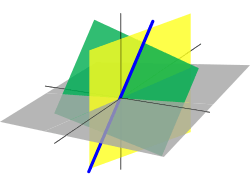Rayleigh–Faber–Krahn inequality
In spectral geometry, the Rayleigh–Faber–Krahn inequality, named after its conjecturer, Lord Rayleigh, and two individuals who independently proved the conjecture, G. Faber and Edgar Krahn, is an inequality concerning the lowest Dirichlet eigenvalue of the Laplace operator on a bounded domain in , .[1] It states that the first Dirichlet eigenvalue is no less than the corresponding Dirichlet eigenvalue of a Euclidean ball having the same volume. Furthermore, the inequality is rigid in the sense that if the first Dirichlet eigenvalue is equal to that of the corresponding ball, then the domain must actually be a ball.
More generally, the Faber–Krahn inequality holds in any Riemannian manifold in which the isoperimetric inequality holds.
See also
References
- ↑ Benguria, Rafael D. "Rayleigh–Faber–Krahn inequality". Encyclopaedia of Mathematics. SpringerLink. Retrieved 6 November 2011.
This article is issued from
Wikipedia.
The text is licensed under Creative Commons - Attribution - Sharealike.
Additional terms may apply for the media files.
